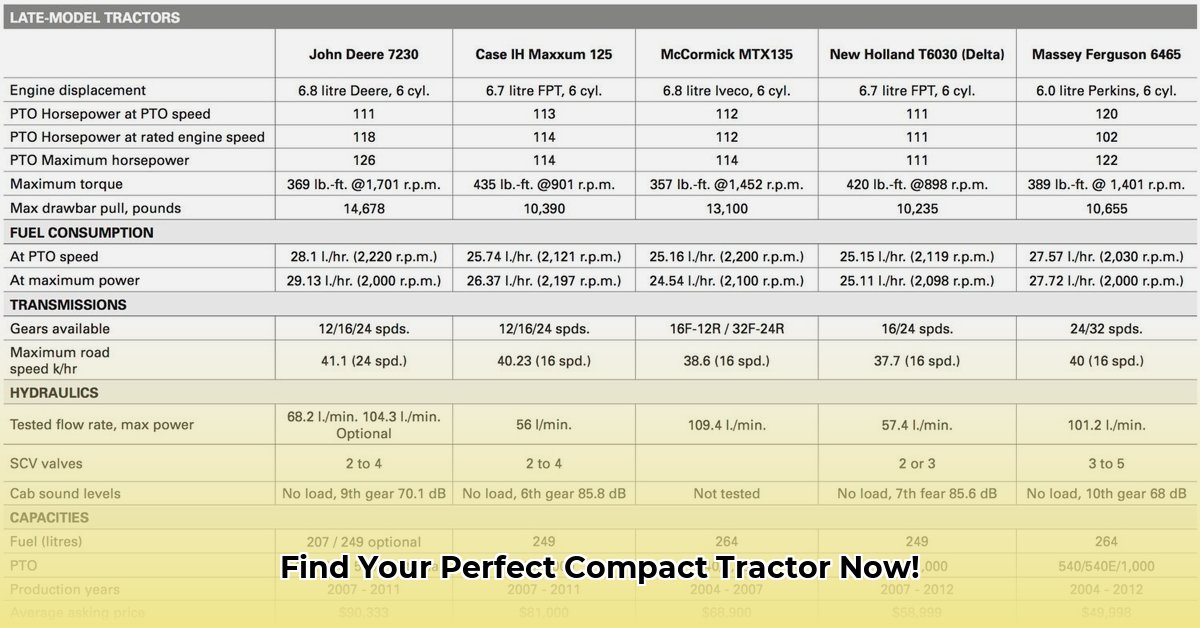
Choosing the right compact tractor can seem daunting, but this comprehensive guide simplifies the process. We'll help you navigate the complexities of horsepower, attachments, and brand comparisons to find the perfect machine for your needs and budget. This guide empowers you to make an informed decision, ensuring a smooth and productive experience with your new tractor. For additional resources on used Kubota compact tractors, check out this helpful resource.
Key Factors to Consider When Choosing Your Compact Tractor
Before you begin browsing dealerships, understanding these key factors is crucial for making an informed decision.
1. Power and Performance: Horsepower and PTO
Horsepower (HP) represents the tractor's engine power. More horsepower generally means more strength for demanding tasks like tilling tough soil or moving heavy materials. However, higher horsepower typically increases the purchase price.
The Power Take-Off (PTO) is a critical component connecting the tractor's engine to attachments like mowers, tillers, and balers. The PTO's horsepower rating usually reflects a portion of the engine's total horsepower. Matching the PTO's power capacity to your intended use is critical for optimal performance. For example, a small lawn mower requires less PTO power than a large, heavy-duty tiller.
Rhetorical Question: Are you primarily focusing on light tasks like mowing, or do you need the power to handle more intensive jobs like tilling rocky soil? This will dictate your horsepower and PTO requirements.
2. Essential Attachments: Expanding Your Tractor's Capabilities
Attachments significantly expand a compact tractor's versatility. Consider which attachments are essential for your intended tasks.
Front-End Loader (FEL): Ideal for moving materials like dirt, gravel, snow, or mulch. The FEL's capacity depends on your needs.
Backhoe: Crucial for digging, trenching, and post-hole digging.
Mower: Various options are available, from rotary cutters for rough terrain to finishing mowers for precise cuts.
Tiller: Used for preparing garden soil; different tillers are suitable for varying soil conditions.
Quantifiable Fact: Adding a front-end loader and a backhoe can significantly increase the overall cost of your tractor, potentially adding thousands of dollars to the overall purchase price. Carefully consider your needs and budget before committing to additional attachments.
3. Brand Reputation and Dealer Support: Long-Term Considerations
Choosing a reputable brand with a strong dealer network is paramount for ensuring long-term satisfaction. While initial purchase price is important, the accessibility of parts, prompt service, and the overall brand's reputation for reliability significantly impacts the overall cost of ownership.
Expert Quote: "Don't underestimate the importance of a strong dealer network," says John Miller, a seasoned agricultural equipment mechanic. "A responsive local dealer can be the difference between a minor inconvenience and a major disruption to your projects."
4. Budget: The Total Cost of Ownership
Compact tractors span a broad price range, from a few thousand to over $50,000. Your budget should encompass not only the tractor but also attachments (if any), routine maintenance, and potential repairs.
Rhetorical Question: Have you considered the ongoing costs beyond the initial purchase price? Maintenance, fuel, and potential repairs all contribute to the total cost of ownership.
5. Maintenance Costs: Unexpected Expenses
Regular maintenance is critical for a tractor's longevity. Factor in oil changes, filter replacements, and routine servicing when budgeting. Extended warranties can mitigate the risk of unexpected repairs, offering peace of mind.
Compact Tractor Comparison Chart
This chart provides a general overview. Specifications may vary by model year and options; consult manufacturer information for precise details.
| Brand | Average Price Range (USD) | Typical HP Range | PTO (HP) Availability | Warranty (Typical Years) | Pros | Cons |
|---|---|---|---|---|---|---|
| Kubota | $10,000 - $50,000+ | 20-60 HP | Varies by Model | 2-4 | Extensive dealer network, robust build, high resale value | Higher initial cost |
| John Deere | $10,000 - $50,000+ | 20-60 HP | Varies by Model | 2-4 | Well-known brand, reliable, extensive parts availability | Often more expensive than competitors |
| Mahindra | $8,000 - $40,000+ | 20-50 HP | Varies by Model | 2-4 | Competitive pricing, often feature-rich for the price | Dealer network varies in quality and support. Quality control can vary. |
| LS Tractor | $8,000 - $40,000+ | 20-50 HP | Varies by Model | 2-4 | Good value for money, often feature-rich, growing dealer network. | Somewhat newer brand, may be less familiar to some buyers. |
A Step-by-Step Guide to Choosing Your Tractor
Assess Your Needs: What tasks will the tractor perform? Consider land size and required attachments.
Define Your Budget: Establish a realistic budget encompassing the tractor, attachments, maintenance, and potential repairs.
Research Models: Explore manufacturer websites, read reviews, and use the comparison chart as a guide.
Visit Dealerships: Test drive multiple models and discuss maintenance and parts availability with dealers.
Compare Warranties: Carefully review warranty terms and conditions.
Finalize Your Decision: Weigh all factors, considering the long-term value and total cost of ownership.
Case Studies: Real-World Examples
The Hobby Farmer: Jane, a hobby farmer, chose a 25 HP Mahindra with a mower and tiller for its cost-effectiveness and versatile attachments.
The Landscaper: Mike, a professional landscaper, opted for a higher-end Kubota model with a powerful front-end loader for its reliability and extensive service network.
Choosing the right compact tractor requires careful planning. By following this guide, you can confidently select a machine that meets your specific needs and budget for years to come.